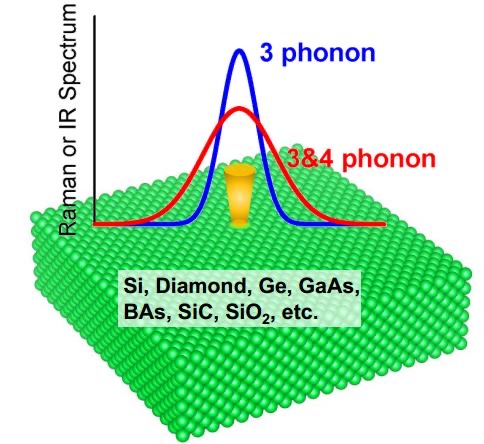Four-phonon scattering in infrared and Raman demonstrated for the first time

The three-phonon scattering and four-phonon scattering processes. Image credit: Tianli Feng, Xiulin Ruan.
Ever wonder how the handheld forehead thermometer works, such as in detecting fevers during the COVID-19 pandemic? It measures the infrared radiation from the body. Besides the human body, infrared radiation is also widely used to measure the temperatures of materials or characterize their properties. In fact, infrared thermal radiation is one of the three primary modes of heat transfer and has wide applications in smart sensing, renewable energy, and nanotechnology. Likewise, Raman spectra are one of the most commonly used methods to characterize materials.
Infrared and Raman spectra of semiconductors and dielectric materials have a quantum mechanics origin. For long, the frequencies of their spectral lines have been associated with the vibrational frequencies of phonons, quanta of lattice vibrations, while the linewidths are associated with the rate of three-phonon scattering, a process where three phonons interact. However, the linewidths from theory were often considerably lower than the experimental data, and the discrepancy was typically attributed to defects or impurities in experimental materials. Moreover, infrared radiation at high temperature is important, but very hard to directly measure. Hence, a better understanding of infrared and Raman spectra and the prediction methods are needed.
Professor Xiulin Ruan from the School of Mechanical Engineering at Purdue University, Professor Yongjie Hu from the University of California at Los Angeles, and Professor Ju Li from the Massachusetts Institute of Technology have published a paper entitled “Observation of strong higher-order lattice anharmonicity in Raman and infrared spectra” in Physical Review B. Dr. Xiaolong Yang and Dr. Tianli Feng, both former members of Ruan’s group, co-led the paper. By using rigorous density-functional calculations and Raman experiments, the authors show that a new mechanism, four-phonon scattering, strongly affects the infrared and Raman spectra for a wide range of materials. Because of the importance of this work, it was published as a Rapid Communication and selected as Editor’s Suggestion.
Phonon scattering is a basis of the quantum theory of thermal conductivity and thermal radiation properties of solids. For more than half a century, it has been believed that three-phonon scattering is the dominating process, while higher-order scattering, such as four-phonon scattering, has been unclear. Understanding four-phonon scattering remained a long time challenge. However, Professor Xiulin Ruan, Dr. Tianli Feng (then a PhD student with Ruan and now a postdoctoral fellow at the Oak Ridge National Laboratory) and their co-workers created the first rigorous formalism for four-phonon scattering (Phys. Rev. B 93, 045202, 2016), and predicted that it could significantly affect the thermal conductivity of materials, especially for strong anharmonic materials, materials at high temperature, and materials with a wide phonon band gap (Phys. Rev. B, 96, 161201(R), 2017). Their prediction on silicon successfully explained its thermal conductivity at medium to high temperatures, and their prediction on boron arsenide was directly confirmed by recent experimental measurements of its very high thermal conductivity (Science 361, 575, 2018; Science 361, 579, 2018; Science 361, 582, 2018). Since then, the four-phonon scattering theory is gaining wide acceptance in the heat conduction community.

Schematic diagram of the effect of four-phonon scattering on IR and Raman spectra. Image credit: Xiaolong Yang and Xiulin Ruan.
In the new study, they turned their attention to whether four-phonon scattering can universally affect infrared and Raman spectra of materials. The short answer is yes; they found that four-phonon scattering generally makes the spectral lines wider and the peaks lower.
Using gallium arsenide (GaAs), a common semiconductor, as an example, results show that four-phonon scattering, not defects or impurities as previously assumed, is responsible for the larger linewidths observed in experiments. As the temperature increases, the role of four-phonon scattering can even exceed that of three-phonon scattering. Similar observations were made on silicon, germanium, boron arsenide, silicon carbide, and quartz. In particular, the linewidth in boron arsenide is completely due to four-phonon scattering, while the role of three-phonon scattering is negligible, a striking result. They explain it with the special phonon spectrum which forbids the energy and momentum conservation of three-phonon scattering but allows that for four-phonon scattering.
With the series of studies on four-phonon scattering by Ruan’s team and other groups, now we know that four-phonon scattering can widely affect two of the three heat transfer modes: heat conduction and thermal radiation. The four-phonon theory has advanced the quantum theory of thermal conductivity, thermal radiation, Raman spectra, and other phenomena. In addition to its scientific significance, it helps to interpret infrared and Raman spectra of materials, and provides the theory and predictive tools to guide the discovery of new materials for heat conduction and thermal radiation applications.
The work was partially supported by the National Science Foundation (NSF) CAREER Award program and Defense Advanced Research Projects Agency (DARPA).
Source: Xiulin Ruan, 765-494-5721, ruan@purdue.edu
Editor: Jared Pike, 765-496-0374, jaredpike@purdue.edu
Observation of strong higher-order lattice anharmonicity in Raman and infrared spectra
Xiaolong Yang, Tianli Feng, Joon Sang Kang, Yongjie Hu, Ju Li, and Xiulin Ruan
The fundamental theory of Raman and infrared (IR) linewidth has been well established as the third-order lattice anharmonicity (three-phonon scattering). In this work, we use both rigorous density functional calculations and Raman experiments to find, surprisingly, that the fourth-order anharmonicity universally plays a significant or even dominant role over the third-order anharmonicity at room temperature, and more so at elevated temperatures, for a wide range of materials including diamond, Si, Ge, GaAs, boron arsenide (BAs), cubic silicon carbide (3C-SiC), and α-quartz. This is enabled by the large four-phonon scattering phase space of zone-center optical phonons. Raman measurements on BAs were conducted, and their linewidth verifies our predictions. The predicted infrared optical properties through the Lorentz oscillator model, after including four-phonon scattering, show much better agreement with experimental measurements than those three-phonon-based predictions. Our work advances the fundamental understanding of Raman and IR response and will broadly impact spectroscopy techniques and radiative transport.
